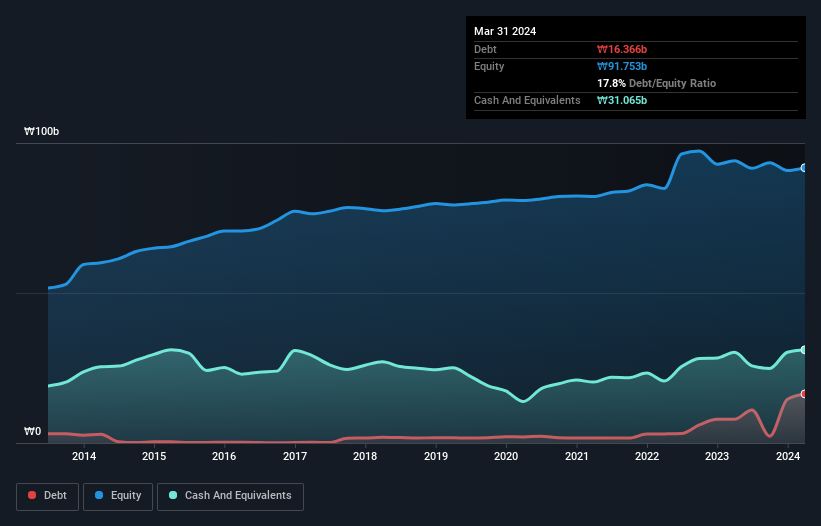
Some say volatility, rather than debt, is the best way to think about risk as an investor, but Warren Buffett famously said that 'Volatility is far from synonymous with risk.' When we think about how risky a company is, we always like to look at its use of debt, since debt overload can lead to ruin. As with many other companies Hanshin Machinery Co., Ltd. (KRX:011700) makes use of debt. But the real question is whether this debt is making the company risky.
When Is Debt A Problem?
Debt is a tool to help businesses grow, but if a business is incapable of paying off its lenders, then it exists at their mercy. In the worst case scenario, a company can go bankrupt if it cannot pay its creditors. However, a more frequent (but still costly) occurrence is where a company must issue shares at bargain-basement prices, permanently diluting shareholders, just to shore up its balance sheet. Of course, debt can be an important tool in businesses, particularly capital heavy businesses. The first thing to do when considering how much debt a business uses is to look at its cash and debt together.
Check out our latest analysis for Hanshin Machinery
What Is Hanshin Machinery's Debt?
The image below, which you can click on for greater detail, shows that at March 2024 Hanshin Machinery had debt of ₩16.4b, up from ₩7.89b in one year. However, it does have ₩31.1b in cash offsetting this, leading to net cash of ₩14.7b.

A Look At Hanshin Machinery's Liabilities
Zooming in on the latest balance sheet data, we can see that Hanshin Machinery had liabilities of ₩20.1b due within 12 months and liabilities of ₩8.14b due beyond that. Offsetting these obligations, it had cash of ₩31.1b as well as receivables valued at ₩25.0b due within 12 months. So it can boast ₩27.8b more liquid assets than total liabilities.
This surplus suggests that Hanshin Machinery is using debt in a way that is appears to be both safe and conservative. Due to its strong net asset position, it is not likely to face issues with its lenders. Simply put, the fact that Hanshin Machinery has more cash than debt is arguably a good indication that it can manage its debt safely. When analysing debt levels, the balance sheet is the obvious place to start. But it is Hanshin Machinery's earnings that will influence how the balance sheet holds up in the future. So when considering debt, it's definitely worth looking at the earnings trend. Click here for an interactive snapshot.
In the last year Hanshin Machinery wasn't profitable at an EBIT level, but managed to grow its revenue by 8.2%, to ₩59b. That rate of growth is a bit slow for our taste, but it takes all types to make a world.
So How Risky Is Hanshin Machinery?
By their very nature companies that are losing money are more risky than those with a long history of profitability. And in the last year Hanshin Machinery had an earnings before interest and tax (EBIT) loss, truth be told. Indeed, in that time it burnt through ₩16b of cash and made a loss of ₩1.6b. But at least it has ₩14.7b on the balance sheet to spend on growth, near-term. Overall, its balance sheet doesn't seem overly risky, at the moment, but we're always cautious until we see the positive free cash flow. The balance sheet is clearly the area to focus on when you are analysing debt. However, not all investment risk resides within the balance sheet - far from it. For example - Hanshin Machinery has 1 warning sign we think you should be aware of.
If you're interested in investing in businesses that can grow profits without the burden of debt, then check out this free list of growing businesses that have net cash on the balance sheet.
If you're looking to trade Hanshin Machinery, open an account with the lowest-cost platform trusted by professionals, Interactive Brokers.
With clients in over 200 countries and territories, and access to 160 markets, IBKR lets you trade stocks, options, futures, forex, bonds and funds from a single integrated account.
Enjoy no hidden fees, no account minimums, and FX conversion rates as low as 0.03%, far better than what most brokers offer.
Sponsored ContentValuation is complex, but we're here to simplify it.
Discover if Hanshin Machinery might be undervalued or overvalued with our detailed analysis, featuring fair value estimates, potential risks, dividends, insider trades, and its financial condition.
Access Free AnalysisHave feedback on this article? Concerned about the content? Get in touch with us directly. Alternatively, email editorial-team (at) simplywallst.com.
This article by Simply Wall St is general in nature. We provide commentary based on historical data and analyst forecasts only using an unbiased methodology and our articles are not intended to be financial advice. It does not constitute a recommendation to buy or sell any stock, and does not take account of your objectives, or your financial situation. We aim to bring you long-term focused analysis driven by fundamental data. Note that our analysis may not factor in the latest price-sensitive company announcements or qualitative material. Simply Wall St has no position in any stocks mentioned.
About KOSE:A011700
Hanshin Machinery
Manufactures and sells air compressors in Korea and internationally.
Adequate balance sheet very low.
Market Insights
Community Narratives




